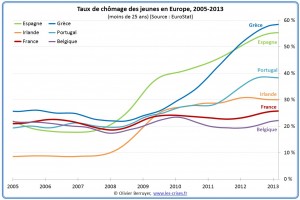GENERATION C: From the Boomers to Generation ALPHA

In 1994, when I first encountered the World Wide Web, I had just started a family. I was in my mid-thirties, and I worked as a consultant in finance and as a development strategist for start-ups. Over the years, I glimpsed the major revolution that was taking place with the Web and its implications for businesses and professionals. Today, with my children having reached adulthood, I can see first hand the impact of new technologies on young people. Therefore, I am often asked the question: How has technology shaped the mind-set of a generation?
Echo Boomers and young boomers: closer than you might think
Ever since the early 90s, the impact of new technology was being observed in young g people. Mark Prensky, author and renowned speaker, regularly commented on the changes he observed in his students at the university. For instance, he noticed a significant metamorphosis in the young people that attended his classes as they became more familiar with new technologies. Their relation with research, knowledge acquisition, and information assimilation was being transformed. In his book, “Digital Natives, Digital Immigrants”, Prensky described the next generation (those born after 1994 and the advent of the World Wide Web) as the first generation of the digital age, the first age bracket having grown up and evolved from the cradle with Web, video games, cell phones and digital media. (See Generating C – The reign of connected consumers).
That was twenty years ago. And although they are not born directly with a remote video game in hand, my children, Justin and Felix, were nevertheless plunged early into the world of new technologies. In this context, even if they were the last cohort of Generation Y, they were closer to the new Generation Z. Today, they find themselves in between the aforementioned two generations, in a sort of buffer zone that exists between Generation Y and Generation Z. Justin and Felix are part of a micro-generation, which is called the Echo Boomers. They are given that label because their current situation is a bit like an echo (or reflection) of what had been experienced before them by young baby boomers in the late 50s, early 60s. That is, like today’s Echo Boomers, Young Boomers found themselves immersed in important social and technological revolutions. For example, Young Boomers grew up with new communications technologies, including television, which opened the door to the global economy while providing unprecedented access to information.
in hand, my children, Justin and Felix, were nevertheless plunged early into the world of new technologies. In this context, even if they were the last cohort of Generation Y, they were closer to the new Generation Z. Today, they find themselves in between the aforementioned two generations, in a sort of buffer zone that exists between Generation Y and Generation Z. Justin and Felix are part of a micro-generation, which is called the Echo Boomers. They are given that label because their current situation is a bit like an echo (or reflection) of what had been experienced before them by young baby boomers in the late 50s, early 60s. That is, like today’s Echo Boomers, Young Boomers found themselves immersed in important social and technological revolutions. For example, Young Boomers grew up with new communications technologies, including television, which opened the door to the global economy while providing unprecedented access to information.
Heavily involved in the social changes of the time, young baby boomers (born between 1956 and 1962) made choices similar to those of the Echo Boomers today, delaying families to devote themselves to the ideals and causes they champion. In each case, the utopia of great revolutions has given way to disillusionment. Today, despite commonalities, there are natural clashes between these generations. Yet, their situations are more alike than many imagine. After all, both generations have lived through wars, economic crises and major social change.
The challenge for new generations to come
In his book, The ABC of XYZ: Understanding The Global Generations, Mark McCrindle tries to explain how collisions between the generations are created, describing the generational cycles of the last century, before the digital age. It describes the cycle of the last century as follows:
 • The Silent Generation (1928-1944) – Artists: Undecided and emotional, they grow up in crisis but are overprotected by their parents. They instinctively retreat into themselves, developing new worlds to escape the economic crisis and war.
• The Silent Generation (1928-1944) – Artists: Undecided and emotional, they grow up in crisis but are overprotected by their parents. They instinctively retreat into themselves, developing new worlds to escape the economic crisis and war.
• Baby boomers (1945-1962) – Prophets: Sanctimonious, bitter, they live through their values and are willing to fight to defend their ideas. They are innately idealistic, utopian and evangelistic; however, they must struggle with the disappointment of their dreams.
• Generation X (1963-1979) – Nomads: Cynics, they are more pragmatic, but at the same time more adventurous. They are not afraid to give up some gains along the way in order to find new experiences and more rewards down the road.
• Generation Y (1980-1994) – Heroes: Energetic and curious, they have always been the center of interest in their lives; personal success is their main goal. This is the era of the ¨selfie¨ and Egocasting.
Today, young people have a natural, almost innate, multitasking approach to life. For them, the cell phone has become an extension of their personality. The Web belongs to them. Their real life is almost entirely formatted from their digital lives. Children of Generation X (and older Generation Y), they were born after the fall of the Berlin Wall and lived their adolescence in the early years of the new millennium. They have experienced the tragedy of September 11, 2011, recurring natural disasters, and the global economic crisis of 2008-2009. More recently, they found themselves at the forefront of the Occupy Wall Street movement, the Arab Spring, and student protest movements around the world. All this reminds me of my youth!
During the 1960s-70s, protesters defended the virtues of peace and love, celebrated-youth culture, and dreamt of great social change. During the 70s, the  young boomers of my time led a social revolution that included student-led protests against the Vietnam War. During the 80s, student led movements were instrumental in the fall of the Berlin Wall and the demise of the U.S.S.R. According to McCrindle’s theory, new generations, in this case Generation Z (1995-2011) and Generation ALPHA (2012-2028), will naturally emerge in the generational cycle, replacing the silent generation on the one hand, and boomers thereafter. According to McCrindle’s theory, each generation is a factor of its times and a reaction to the generation that came before. If we subscribe to McCrindle’s theory, then the newly emerging generations will have a challenge ahead. The legacy of previous generations has bequeathed to today’s youth a less promising future. Today, the youth demographic represents more than 50% of the world population. This cohort has a disproportionate social influence. Within ten years, young people will constitute more than half the labor force. If our society is no longer able to offer these young people a stable and secure future, then foundations of the current economic system will be shaken.
young boomers of my time led a social revolution that included student-led protests against the Vietnam War. During the 80s, student led movements were instrumental in the fall of the Berlin Wall and the demise of the U.S.S.R. According to McCrindle’s theory, new generations, in this case Generation Z (1995-2011) and Generation ALPHA (2012-2028), will naturally emerge in the generational cycle, replacing the silent generation on the one hand, and boomers thereafter. According to McCrindle’s theory, each generation is a factor of its times and a reaction to the generation that came before. If we subscribe to McCrindle’s theory, then the newly emerging generations will have a challenge ahead. The legacy of previous generations has bequeathed to today’s youth a less promising future. Today, the youth demographic represents more than 50% of the world population. This cohort has a disproportionate social influence. Within ten years, young people will constitute more than half the labor force. If our society is no longer able to offer these young people a stable and secure future, then foundations of the current economic system will be shaken.
Unemployment among young people; a power bomb!
In an article published shortly after the “Occupy Wall Street” demonstrations, entitled ‘The World’s Unemployed Youth: Revolution In The Air?’, the Canadian author and speaker, Don Tapscott, raised unemployment among the younger generation as a potential “time bomb.” He’s right. Currently, more than a quarter of young Canadians and Americans cannot find a job. In England, young people aged 16 to 24 accounts for over 20% of the unemployed in the country (that represents more than 1 million young adults without work). Elsewhere in Europe, the rate of youth unemployment approaches 50% in Spain and 60% in Greece. In the United States, unemployed youth represent more than a quarter of the population (25.9%). Indeed, among those young Americans arriving in the labor market, almost 60% polled are worried about their future. Among Generation Z, 75% are concerned about the fate of the planet, and 60% want their work to have impact on the world.
 (Source Image : Olivier Berruyer – Les-crises.fr)
(Source Image : Olivier Berruyer – Les-crises.fr)
Making youth employability first business priority
Today, Generation Z and young Echo Boomers are much more cynical about the future. They totally turn their backs to the system of society, which they reject outright. Not only do they experience a crisis of unprecedented unemployment, but they are also helpless witnesses broken dreams of their parents abuse their grandparents, and all social injustices and organized official corruption. Today, youth keeps his finger on the trigger of the Web; the most formidable tool changes. As she has demonstrated repeatedly in recent years, especially with the Arab Spring, which has made several governments bent, and where Facebook, Twitter and YouTube have played a major role.
But if we do not take action now, what happens today will have very serious repercussions in the coming decades. Companies must make employability of young generations their first priority. We need to reinvent our educational institutions, and implement new models of financing and governance, to adapt to new economic paradigms imposed now the digital age in which we live. We need to stop putting obstacles in the way of new generations, and to try to control everything, and instead hand them the keys to the company. We need to engage them from the start in the transformation process, and do everything possible to foster the emergence of their creativity and their passions in their workplace.
What do you think? Do you believe that employability among youth must become a priority for businesses? That workplaces should now be in their image? Share your comments and experiences? How do you integrate young people in your workplace?
Additional Images: Copyright: www.123rf.com/profile_koca777
http://www.desertusa.com/dusablog/once-upon-a-time.html
Raymond Morin
Latest posts by Raymond Morin (see all)
- The Growing Importance of Blockchain Technology - September 7, 2017
- From a Social and Solidarity Economy to a Sharing Economy - August 24, 2017
- The Changing Landscape of Social Media Usage - April 10, 2017

